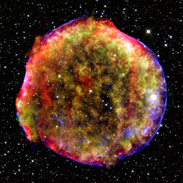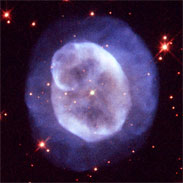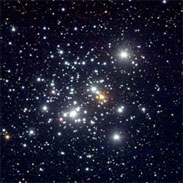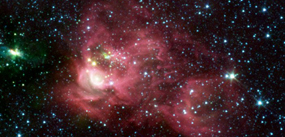Syllabus
Download & Print [pdf]
See also:
Memo to Undergraduate Astronomy Students Regarding Astronomy Courses
SYLLABUS FOR ASTRONOMY 309N:
"LIVES AND DEATHS OF THE STARS"
https://www.as.utexas.edu/astronomy/education/fall12/dinerstein/309n.html
Course Unique No. & Semester: 47760, Fall 2012
Class Meetings: Tues. & Thurs., 9:30 – 10:45 AM, Welch 3.502
(stand-alone auditorium with separate entrance at the back of the building)
Instructor: Professor Harriet Dinerstein, RLM 16.324
office hours: Tues. 2-3 PM
Instructor Contact Info: 471-3449, harriet@astro.as.utexas.edu
Pre-Exam/Quiz Help Sessions: Wed., 4:30 – 5:30 PM, RLM 15.216B
Teaching Assistants:
|
Brian Mulligan, RLM 16.216 |
& |
Alan Sluder, RLM 16.327 |
IMPORTANT NOTE ABOUT PREREQUISITES AND CREDIT:
Students registering for 47760 should be aware that Ast 309N has a prerequisite of AST 301 or an equivalent college-level introductory astronomy course. The system will not check your transcript and bar you from enrolling if you do not meet this requirement, but we strongly advise against taking Ast 309N without having had a prior introductory class. In Ast 309N we will assume that you already have a working knowledge of the concepts covered in the introductory course, and will go into more depth on selected topics. If you do not have this background, you will be at a serious disadvantage. My experience has been that in these cases the students nearly always end up falling behind and dropping the class. Also, natural sciences majors should be aware that Ast 309N will not count towards their major.
COURSE CONTENT AND GOALS:

Tycho's Supernova Remnant [NASA]
The AST 309s are special-topics classes designed specifically for non-science majors, intended to follow a one-semester Introductory class such as AST 301. The letters following 309 indicate different subject matter. In Fall 2012, we have three sections: AST 309R – “Galaxies, Quasars, and the Universe,” AST 309 – “The Birth of Stars and Planets,” and this class, AST 309N, which will describe the nature and life stories of stars of all kinds, from the normal to the exotic. We will begin with our very own star, the Sun; discuss the range of properties of ordinary stars, as well as their orbiting planets; and review how stars age and die, leaving behind weird objects such as neutron stars and black holes. My primary goals are for you to:
(1) acquire a broad grasp of the nature of stars and their role in shaping our universe; (2) be able to understand and judge the accuracy of media reports on astronomical discoveries; and (3) practice and develop your skills at assimilating complex new material and being able to answer questions about it in a clear and concise way. It’s possible, even likely, that this third objective will be the most useful in the long run!
TEXTBOOKS AND RESOURCES:
There is no single book that addresses every topic we will discuss. I have ordered two books that, together, cover most of the material. During the first half of the semester we will use the recommended book “Extreme Stars” by James Kaler. As an alternative to buying this book, you may consult the textbook you used for your introductory course, or borrow/rent/buy any recent introductory astronomy textbook. About halfway through the semester we will switch to topics covered in the required book, “Cosmic Catastrophes: Exploding Stars, Black Holes, and Mapping the Universe,” by J. Craig Wheeler (2007); these topics are not covered in much detail in typical introductory textbooks. Note that this is actually the second edition of “Cosmic Catastrophes.” The first edition (2000) had a different subtitle, “Supernovae, Gamma-Ray Bursts, and Adventures in Hyperspace.” Be sure you buy the correct (later) edition! Both Wheeler and Kaler are available at the Co-op and at Austin TXbooks (check for the best prices). Wheeler’s book is also available as an eBook through the UT libraries, but there may be restrictions on how many students can view it at once or how much of the book can be downloaded at a time.
In addition to these books, the instructor for Ast 309N will be posting selected slides from class meetings, as well as links to relevant websites. However, due to copyright laws, video segments shown in class will not be posted on the class website.
COURSEWORK AND GRADING PLAN:

Planetary Nebula NGC 5979 [STScI]
My grading philosophy is that all students should have the opportunity to earn a grade based on their own work, so I do not set quotas for A’s and B’s. After the first exam, I will post a table of numerical score = letter grade equivalents, to be used for the rest of the semester (barring extraordinary circumstances). I do use +, − grades.
Your course grade will be based on a combination of hour exams, short-essay quizzes, and numerous short in-class activities that accumulate participation credit. A few out-of-class activities such as UT Star Parties may be used to earn a small portion of the total participation credit. I provide some flexibility for students by scheduling more quizzes and activities than needed for 100% of the credit, so an occasional missed quiz (or lowest score) can be dropped. The flip side of this policy, however, is that I do not give make-ups for specific missed assignments. Instead, I expect you to replace that item with a later activity or quiz that provides the equivalent credit. I also do not give exams early to individual students; all exams must be taken at the same time as the rest of the class. There are no exceptions. Also, students who skip many classes and attend only on exam dates will find it difficult to do well, or even pass; this course is not designed to be taken “by exam.”
In-class Exams: There will be 3 “unit” exams, each worth 20% of the course grade, for a total of 60%. Exams 1, 2, and 3, scheduled on Oct. 4, Nov. 8, and Dec. 6, will each focus on material presented during the previous period. The format will be mixed, multiple-choice and short essay. There will be an extra exam (Exam 2.5) on Nov. 15 or 20, which can serve as a make-up exam for either Exam 1 or 2. Given convincing documentation (judged by this professor!) for missing or doing poorly on Exam 3, I may count Exam 2.5 in its place – if it was taken on the designated date.
Quizzes: We will have at least 6 quizzes, comprised of short-essay questions that serve as practice for the essay parts of the exams. These also address the third goal for the course. The 5 best quiz scores count for 20% of the course grade.
Participation and Other Assignments: The remaining 20% of the grade will come from credit earned over the semester, through in-class activities, documented attendance at UT Star Parties (up to 3 may count) or public lectures (if available; will be announced in class), and other structured out-of-class, written assignments.
CLASSROOM EXPECTATIONS AND POLICIES:
I expect students to attend class regularly and to stay engaged with class activities. This is the best and most efficient way to become familiar with the material and prepare effectively for quizzes and exams. I understand that students occasionally become ill or have an unavoidable conflict, and have arranged the classwork to make allowances for missing a couple of classes. Consequently, I do not provide make-up opportunities for individual missed quizzes or assignments, but instead expect students to make up the credit through the designated opportunities.

Jewell Box Cluster [M.Bessell]
In order to make class time more valuable and minimize distractions for classmates and the instructor, there will be no cell phone use, including texting, during class (and make sure the ringer is off!). I also very strongly discourage the use of laptops in class. They are a major distraction to the user and others. If you must use them, for example to take notes, you must sit in the last two rows of the auditorium.
In general, I expect students to treat their instructors and classmates respectfully, which means remaining silent while others are speaking (unless directed to “talk to your neighbor”!), and avoiding disturbing or disrupting the class by your actions (such as entering or exiting the classroom in a conspicuous and loud manner, carrying on conversations, singing or “spill-over” from an iPod, snoring, etc.). Carrying on activities unrelated to this class on your computer is also distracting to those sitting behind you, which is why I restrict computers to the back of the classroom. However, I should point out that if you are not paying attention to the class, you are not benefitting from being present, so why bother?
KEY DATES FOR FALL 2012: (applicable to other classes as well)
First class meeting: Thurs., Aug. 30
Last day to add Ast 309N (end of free adds/drops period): Tues., Sep. 4
Last day to add any class, or to drop with a possible refund: Fri., Sep. 14
Last day to drop Ast 309N or to change your grading basis between letter grade
and credit/no-credit: Tues., Nov. 2
(This is the last day for academic drops; after this you need your dean’s approval for a verifiable non-academic reason, aside from the one-time exception)
Last class meeting and date of last exam: Thurs., Dec. 6
PRELIMINARY SCHEDULE OF TOPICS: (subject to change)
|
Dates |
Topics |
Kaler |
Wheeler |
|
8/30-9/11 |
The Sun: activity, interior, & neutrinos |
ch. 1 |
ch. 1 |
|
9/13-9/25 |
Review: light, energy, stellar properties |
ch. 1 |
ch. 1 |
|
9/27-10/02 |
Star clusters, Main sequence, & brown dwarfs |
ch. 2 & 5 |
--- |
|
10/09-10/11 |
Extrasolar planets |
--- |
--- |
|
10/16-10/18 |
Life stories of sun-like stars |
ch. 3, 4 |
ch. 2 |
|
10/23-10/25 |
Life stories of massive stars |
ch. 6 |
ch. 6, 7 |
|
10/30-11/01 |
Interacting binaries; white dwarfs |
ch. 7 |
ch. 3, 4, 5 |
|
11/06-11/08 |
Neutron stars: pulsars & other exotica |
--- |
ch. 8 |
|
|
Black holes, Gamma-ray bursts, etc. |
--- |
ch. 9-11 |
|
11/27-11/29 |
Supernovae & an accelerating universe |
--- |
ch. 12 |
|
11/29-12/04 |
The oldest stars; "first stars" |
ch. 9 |
--- |
Scholastic Integrity/Academic Dishonesty: The University of Texas at Austin’s honor code is posted at http://deanofstudents.utexas.edu/sjs/spot_honorcode.php. Also http://deanofstudents.utexas.edu/sjs/index.php; especially the links on “academic integrity.” We take these rules seriously. We will not tolerate copying or cheating on exams, homework, or other classwork. If we find duplicated work or evidence of cheating, no student involved will receive credit. We may also impose stronger academic penalties such as a grade of F and/or a report to the Dean of Students.
Getting Help with this class: There will be several opportunities every week to get help, including help sessions most Wed. afternoons from 4:30 – 5:30 PM in RLM 15.216B, and office hours with the TAs and instructor. Please try to come at the listed times, but if none of them work for you, contact one of us to schedule an alternate appointment. You can also send questions by email. However, if your question is about procedures, please check the class website first, to see whether the answer is already there.
Students with Disabilities: The University of Texas at Austin provides academic adjustments for students with certified disabilities. Contact the Office of the Dean of Students at 471-6259, or (TTY) 471-4641, or email ssd@uts.cc.utexas.edu. In a class this size the instructor must rely on the SSD office to provide alternate arrangements for classwork. Since these services need to be scheduled in advance, you need to inform the instructor as soon as possible in order to make these arrangements.
Star Parties: The Astronomy Department offers Star Parties most Wed., Fri., and Sat. evenings. Details are posted at http://outreach.as.utexas.edu/public/viewing.html. You can earn credits by attending star parties, if you obtain a signed slip from the person in charge. Warning: Star parties are held only when you can see stars. If one is cancelled due to bad weather, you can’t earn credit for it!

Professor
RLM 16.324 · (512) 471-3449 · email
Office Hours
TBA
TA
Brian Mulligan
TA
Alan Sluder
Pre-Exam/Quiz Help Sessions:
Wed., 4:30-5:30 PM, RLM 15.216B